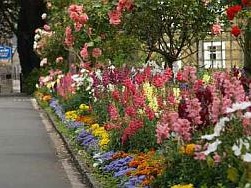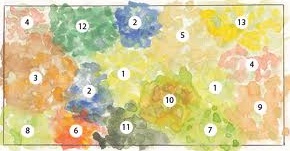Categories
Calendars
Guides
Reviews
Archive
Gallery
Articles
Ask Our Gardening Expert
Seed Borders
There is nothing simpler than buying plants and planting them to produce instant results. We seem to have forgotten that growing your own annual plants from seed is a satisfying and economical way of improving a garden’s appearance. Growing your own plants from seed will give your garden a point of difference from your neighbours and will provide you with masses of cut flowers for your home and welcome gifts for your friends. An annual border gives a small space immediate impact. It is also an easy way of filling an empty space while you decide what to grow next or filling a space while waiting for larger plants to establish themselves.
The result of good planning and planting
Begin by buying your seeds from a reliable source, checking the sow by dates. Most seeds deteriorate after a year, those in airtight foil packets last longer but must be planted soon after opening. As well as normal retail outlets, less common varieties are available online and through mail order catalogues. Packets should bear short cultivation notes, sowing times and germination periods.
We can sow directly into soil where the plants flower in either autumn or spring for most summer flowering varieties of ‘hardy’ annuals and autumn for spring flowering varieties. ‘Half hardy’ annuals are best started in trays indoors and planted out when danger of frost is past. The site must be sunny and well drained. Prepare the soil about a week beforehand by digging, adding fertiliser or organic matter. Immediately before sowing, rake over the surface to loosen the top layer. Seeds can be planted in drills in the same way as vegetable seeds are planted or broadcast and raked in. Planting in drills produces rows of seedlings that are easily distinguished from weeds and can be thinned and hoed. The ‘thinnings’ can be planted to fill empty spaces in the rows or fill between perennial plants to give an exuberant cottage garden effect. Spare seedlings can also be planted in the vegetable garden to provide more cut flowers for the house and at the same time, make the vegetable garden more interesting. One of the advantages of growing annuals is that they seem to produce more blooms after picking, so cut as many as you can.
Setting out the plan on paper avoids mistakes
Read the catalogue and seed packet notes carefully to work out the planting plan. Avoid too much white, it gives a spotty effect from a distance. Note the heights of the plants so that the smallest plants will be at the front or at the edge and the tallest plants at the rear. Try to form a height gradient, it shows of the blooms to their best effect. Consider foliage as another attribute.
A good idea is to plan the border on paper first, marking out the areas of each plant species and then transfer the plan to the flower bed after the drills have been drawn with the edge of the hoe or tool handle. Plant to create large areas of colour and avoid straight lines. The areas for each plant type can be marked out with dry sand so that they can be easily seen, the seeds are then trickled into the drills, covered, firmed and watered. Germination times may vary according to seed type and temperature, so a little patience is needed for the late starters. As the first seedlings appear, remove any weeds. As growth gets under way, the gaps between the plants quickly close and a canopy forms.
A wide variety of plants are now available from garden centres. Produced by wholesale nurseries, we are familiar with the blues of lobelia, the salvias, the alyssum and the petunias in all their colours. They are indeed the most popular subjects and provide immediate impact, especially when used to fill containers. 
